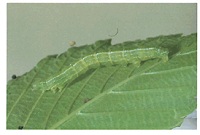Spring: Paleacrita vernata Fall: Alsophila pometaria
Hosts
Maple, Elm and Ash
Appearance and Life Cycle


There are two species of cankerworm, spring cankerworm and fall cankerworm. Adult spring cankerworms emerge and deposit eggs in late March and throughout April, whereas fall cankerworm adults emerge and deposit eggs from late September throughout October. Adult males are small-bodied, brownish-grey moths with a 25 mm wing span, whereas females are dark brownish-grey, wingless and 12 mm in length. The larvae of both species emerge in the spring just as the leaves begin to appear and will feed on the foliage until mid-June. Full grown larvae measure 30 mm in length and they range in color from yellowish-green to brownish-green to black. The only means to distinguish cankerworm during the larval stage is to view the false legs at the rear of the caterpillar. Spring cankerworm have two pairs of false legs compared to three pairs on the fall cankerworm. When feeding is complete, the larvae enter the soil where they remain until they emerge as adults, that fall or the following spring depending on the species.
Damage
Cankerworm cause damage by defoliation during the larval stage. Initial feeding causes a shot-hole appearance in the leaves, but advance feeding results in the entire leaf being consumed except for the main veins. Most trees will re-leaf within three weeks after a severe attack. Trees that are defoliated several years in a row will show branch die-back in the crown area.
Control
For a small number of trees, tree banding is an effective method for controlling cankerworm. The bands are covered with a layer of sticky adhesive which prevents the wingless females from climbing the trees to lay eggs. For the spring cankerworm, the bands must be in place from mid-March to late April, whereas for the fall cankerworm, the bands should be in place from late September to early November. Chemical control can be achieved by using carbaryl or methoxychlor. A biological insecticide known as Bacillus thuringiensis is a safe alternative to chemical control.